Inducing multiple polarizations in core@double-shell structured MXene/PVDF flexible nanodielectrics toward elevated overall dielectric performances
Abstract
Titanium carbide (MXene) has garnered much attention in the development of high-permittivity (ε) flexible polymeric dielectrics because of its exceptionally high electrical conductivity; nevertheless, large dielectric loss at the percolating filler loading severely restricts their engineering applications. In this work, the exfoliated MXene was first surface-oxidized (O-MXene) and then encapsulated with a polydopamine (PDA) layer, and the dielectric properties of the O-MXene@PDA/polyvinylidene fluoride (PVDF) nanocomposites were investigated. The findings reveal that compared with both pristine MXene and MXene@PDA, the double-shell O-MXene@PDA imparts PVDF with evidently enhanced ε and breakdown strength (Eb) along with significantly lower dielectric loss. The elevated ε is ascribed to the O-MXene@PDA inducing multiple intra-particle and inter-particle polarizations. The presence of double shells not only induces deep charge traps capturing mobile charges but also raises the energy barrier for trapped charge de-trapping, subsequently leading to remarkably restrained loss and leakage current in the nanocomposites. Moreover, the second PDA interlayer enhances interfacial interactions between MXene and PVDF, and notably mitigates the strong dielectric mismatch between the two components, therefore lessening the formation of electric trees and promoting the Eb. The theoretical fitting and simulations provide deep insights into the underlying multiple polarization mechanisms and the impact of the double shells on charge migration. This core@double-shell approach offers new insights into the fabrication and design of percolating nanocomposites at low filler loading with concurrently high ε and Eb but low loss, presenting potential applications in power electronic devices and power systems.
Keywords
INTRODUCTION
Among contemporary energy storage systems, electrostatic energy storage devices based on dielectric materials have garnered substantial research interest across advanced electronic systems due to their ultrahigh power densities stemming from rapid charge-discharge capacities, exceptional cyclic durability, and enhanced energy storage capacity[1,2]. Compared with traditional ceramic dielectrics, dielectric polymer materials emerge as prime candidates for advanced energy storage systems owing to their inherent merits, including excellent mechanical flexibility, low mass density, facile processability, cost-effectiveness, strong chemical resistance, and superior breakdown strength (Eb). However, their inherently limited dielectric constant (ε) remains a primary constraint impeding practical engineering applications in contemporary electronic and power systems[3].
To effectively address the aforementioned issue, numerous studies have shown that an effective way to enhance the comprehensive dielectric properties of polymers involves incorporating high ε inorganic ceramics into the host matrix, including copper calcium titanate (CCTO), potassium niobate (KNbO3), and lead zirconate titanate (PZT)[4,5]. However, introducing inorganic ceramics to enhance the ε of polymers typically necessitates a substantial amount of filler doping, always exceeding 50 vol%, which can complicate the preparation and processing of the composites and lead to excessive interfacial defects within the composite dielectrics, inevitably compromising the electrical resistivity, Eb and mechanical properties of the resulting nanocomposites to some extent. Another alternative method involves incorporating small amounts of conductive fillers into host polymeric materials to successfully improve the dielectric characteristics of the composites[6-9]. The ε undergoes a substantial rise as filler concentration nears or slightly exceeds the percolation threshold (fc). Nevertheless, this method concurrently induces undesirable large leakage current and dielectric loss (tanδ). Therefore, the precise control of fc remains critical; balancing high permittivity and enhanced Eb with minimized tanδ continues to be a remarkable challenge in the development of high-performance flexible polymeric dielectrics[10].
It is evident that in order to manage the fc, complex microstructure optimization of percolating systems is required. Numerous studies indicate that designing and creating core-shell structures has become a feasible approach to improve dielectric performance and insulating capacity in polymeric composites[11-13]. Applying insulating coatings onto conductive cores in core-shell designs prevents neighboring conductive particles from directly contacting each other, effectively suppressing charge carrier migration and consequently reducing leakage currents and tanδ[14]. Moreover, the shell functions as a reliable buffer layer, demonstrably hindering long-range charge migration within the composites while enhancing interfacial interactions, lessening the interfacial dielectric mismatch and electric field distortion, leading to improved Eb. In addition, the core@double-shell structured fillers exhibit a more adaptable and efficient approach to reducing tanδ and enhancing Eb compared to the conventional core@single-shell structured particles[15,16]. The presence of diverse phase interfaces encourages interfacial polarization (IP), which raises the ε at low frequency and increases the filler’s contribution to ε at high frequency. For instance, Chen et al. created the core@double-shell Al (aluminum)@Al2O3 (alumina)@PDA (polydopamine)/poly(vinylidene fluoride) (PVDF) and discovered that the Al@Al2O3@PDA/PVDF not only improves the IP effect but also significantly impedes long-range electron movement, thus leading to increased ε and reduced tanδ compared to Al@Al2O3/PVDF[17]. Wang et al. fabricated the Mo (Molybdenum)@MoO3 (molybdenum trioxide)@PS (polystyrene)/PVDF composites, demonstrating that incorporating an insulating double-shell substantially reduced the tanδ and enhanced the Eb while preserving the moderate ε[18].
Choosing appropriate fillers is essential for obtaining composites with excellent dielectric and mechanical properties[19,20]. Titanium carbide (MXene), a family of two-dimensional (2D) transition metal carbides/nitrides, has recently gained considerable research interest due to its distinctive structure and outstanding properties, including a large specific surface area, homogeneous dispersion in solvents, high electrical conductivity, and excellent chemical stability[21-23]. When this filler is incorporated into the polymer matrix, it can induce greater charge accumulation at the interfaces between the two components, thereby enhancing the IP effect and significantly increasing ε of the nanocomposites; however, it inevitably displays high tanδ due to leakage-current generation when the filler loading is close to the fc[24,25]. To reduce the leakage current and tanδ in unmodified MXene/polymeric composites, Wang et al. proposed the MXene@MoS2 (molybdenum disulfide)/PVDF films, and found that the MoS2 interlayer notably reduced the composites’ tanδ and conductivity and maintained a moderate ε[26].
Guided by the aforementioned insights, in this study, dopamine (DA) self-polymerization was used to create a novel class of PDA coater for MXene nanosheets. The selection of PDA as an interlayer arises from its rich hydroxyl and amino functional groups, which synergistically optimize interfacial compatibility while generating deep traps to immobilize free charges, thus suppressing tanδ and improving Eb[27,28]. To further enhance the dielectric performances of the MXene@PDA/PVDF nanocomposites, a double-shell was decorated onto raw MXene surface; i.e., the pristine MXene was first oxidized to be O-MXene, and then further encapsulated with PDA to produce the O-MXene@PDA. PVDF was selected in this work due to its exceptional combination of elevated ε, chemical stability and flexibility, rendering it particularly suitable for demanding electrical and electronic devices. It is interesting that the presence of the core@double-shell O-MXene@PDA enables the synergistic regulation of fast intraparticle polarization at high frequency and slow interparticle polarization at low frequency, a decoupled control that cannot be achieved in pristine MXene/PVDF or core@single-shell MXene@PDA/PVDF composites. The double-shell induces multiple polarizations leading to elevated permittivity, which is always reduced in typical core@single-shell particles/polymer. At the same time, the double-shell not only significantly suppresses both leakage current and tanδ, but also boosts Eb due to insulating shielding effect on charge-carrier migration. Further, this study provides a deeper theoretical insight into the double-shell’s impact on the charge migration and underlying polarization mechanism.
EXPERIMENTAL
Materials
Titanium aluminum carbide (Ti3AlC2, ≥ 98.0%) was obtained from Shanghai Haohong Biomedical Technology Co., Ltd., China. Lithium fluoride (LiF, 99%) was supplied by Shanghai Macklin Biochemical Co., Ltd., China. Tris(hydroxymethyl)aminomethane (Tris-HCl, ≥ 99.0%) and dopamine hydrochloride (DA, > 99%) were obtained from Shanghai Aladdin Biochemical Technology Co., Ltd. PVDF (FR903, 99.5%) was employed as the polymer matrix and sourced from Shanghai 3F New Material Technology Co., Ltd., China. N, N-dimethylformamide (DMF, 99.8%) was acquired from Tianjin Chemical Reagent Co., Ltd., China. The relative permittivities for MXene, PDA, and PVDF are 104, 3, and 11, respectively, and their electrical conductivities are 1 × 103 S/m, 1 × 10-9 S/m, and 1 × 10-12 S/m (25 °C, 100 Hz).
Preparations
The full preparation process of O-MXene@PDA/PVDF nanocomposites is illustrated in Supplementary Figure 1.
Preparation of MXene nanosheets
MXene nanosheets were prepared through selective etching of Al (aluminum) atomic layers from Ti3AlC2 phase precursors using a LiF/HCl hydrofluoric etchant. Supplementary Figure 1 provides a detailed description of the preparation process.
Surface modifications of MXene nanosheets
The prepared MXene was exposed to air at 80 oC for 24 h to ensure full surface oxidation, and the oxidized MXene is marked as O-MXene. The obtained O-MXene or pristine MXene was first dispersed into 40 mL of ethanol and stirred magnetically for 30 min, and then heated in a water bath at 35 oC. Next, a specific mass of DA was added to the above suspension. Subsequently, the reaction mixture pH was adjusted to 8.5 using Tris-HCl buffer, followed by magnetic stirring for 10 h. Finally, the mixture was centrifuged and washed several times with deionized water. All samples were dried in an oven at 80 oC for 12 h. The prepared O-MXene, MXene@PDA and O-MXene@PDA nanosheets are referred to as MXene-1, MXene-2 and MXene-3, respectively, in contrast to the raw MXene named as MXene-0.
Fabrication of PVDF nanocomposites
PVDF nanocomposites were synthesized via a solution casting approach. The detailed preparation procedure is shown in Supplementary Figure 1.
Characterizations
Detailed characterizations are presented in the Supplementary Materials.
Simulation
Comprehensive descriptions are detailed in the Supplementary Materials.
RESULTS AND DISCUSSION
Characteristics of the core@double-shell structured fillers
Figure 1A and B presents the transmission electron microscopy (TEM) morphological images of different fillers. In Figure 1A, an evident PDA layer is coated on the surface of MXene-0. Furthermore, the oxide shell is additionally coated with a second layer of PDA, forming the core@double-shell structured O-MXene@PDA [Figure 1B]. As observed from Figure 1C and D, the pristine MXene exhibits a smooth surface morphology, while the O-MXene@PDA nanofillers display enhanced surface roughness. To validate the surface chemical composition, the energy dispersive X-ray spectrometry (EDS) elemental mapping was systematically performed on the O-MXene@PDA nanosheets [Figure 1E], which clearly identifies the characteristic elements C, O, N and Ti. These results are consistent with the characterization results from Fourier transform infrared spectroscopy (FT-IR) and X-ray diffraction (XRD), offering definitive evidence for the presence of the oxide layer and PDA coating on pristine MXene.
Figure 1. TEM images of (A) MXene and (B) O-MXene@PDA nanosheets; SEM images of (C) raw MXene and (D) O-MXene@PDA; (E) EDS elemental mapping of O-MXene@PDA; FT-IR spectra (F) of MXene, O-MXene and O-MXene@PDA; XRD patterns of (G) Ti3AlC2, MXene, MXene@PDA and O-MXene@PDA, (H-J) XPS spectra of O-MXene@PDA, Ti 2p3/2 and N 1s; SEM images of PVDF composites incorporating (K and L) pure MXene and (M and N) O-MXene@PDA. TEM: Transmission electron microscopy; MXene: titanium carbide; O-MXene: oxidized MXene; PDA: polydopamine; EDS: energy-dispersive X-ray spectroscopy; FT-IR: Fourier-transform infrared spectroscopy; XRD: X-ray diffraction; XPS: X-ray photoelectron spectroscopy; Ti3AlC2: titanium aluminum carbide; PVDF: polyvinylidene fluoride.
Figure 1F presents a comparative analysis of FT-IR spectral analysis among pristine MXene, O-MXene and O-MXene@PDA. The characteristic peak observed at 563 cm-1 in the oxidized MXene can be assigned to the vibrational absorption bands of Ti–O bonds. Additionally, this phenomenon likely arises from interfacial coupling interactions between titanium oxide (TiO2) and the residual carbon framework or intermediate carbon-oxygen structures. The surface oxidation process does not lead to complete conversion of MXene into TiO2. Especially, the O-MXene nanosheets treated with PDA exhibit a markedly enhanced absorption peak at 1,600 and 3,440 cm-1, corresponding to the -OH group of the PDA surface. The absorption peak at 1,350 cm-1 is related to the C–N bond in arylamine. It can be concluded that the oxide and PDA layers were successfully coated on the surface of MXene. Figure 1G displays the XRD spectra of Ti3AlC2 and MXene. Notably, the characteristic peak of the Al layer at 2θ = 39° is completely absent in MXene, confirming the success of the etching process in this study. In addition, the (002) diffraction peak of Ti3AlC2 has shifted from 9.6° to 7.3°, and this shift reflects an increase in MXene interlayer spacing resulting from acid etching and ultrasonic delamination, demonstrating successful exfoliation. There are no new crystalline peaks shown in the MXene@PDA and O-MXene@PDA nanosheets, confirming the amorphous nature of both the oxide and PDA shells.
To investigate the successful construction of the core@double-shell structure, The X-ray photoelectron spectroscopy (XPS) spectra are shown in Figure 1. Figure 1H presents the full spectrum of O-MXene@PDA, while high-resolution spectra of Ti and N appear in Figure 1I and J. The full spectrum confirms that the O-MXene@PDA comprises four primary elements: Ti, N, Ti and O. As shown in Figure 1I, the peak observed at 258.0 eV corresponds to the Ti–O bond (Ti4+), confirming successful surface oxidation of the MXene. The presence of the Ti-N peak at
The morphological analysis presented in Figure 1K and L indicates numerous voids and defects in the pristine MXene/PVDF nanocomposites, attributed to weak interfacial compatibility between the high surface energy nanofillers and the host matrix. However, O-MXene@PDA demonstrates significantly fewer voids and defects [Figure 1M and N], which results from improved interfacial interaction because of two main factors: (i) The presence of numerous surface -OH groups from the PDA shell facilitates hydrogen bonding with fluorine atoms in PVDF; (ii) The elevated surface roughness of coated particles facilitates stronger mechanical interlocking with PVDF polymer chains, leading to exceptional dielectric and performance in the nanocomposites.
Dielectric properties
The ε of a polymer is intricately linked to the energy storage capabilities of polymer-based film capacitors[29]. The dependence of ε in PVDF-based nanocomposites on filler loading and applied frequency is systematically summarized in Figure 2. As illustrated in Figure 2A-C, the ε of all nanocomposites exhibits a frequency-dependent attenuation, primarily governed by the delayed response of dipole reorientation and interfacial space charge accumulation within the PVDF matrix to alternating electric fields at elevated frequencies, thereby reducing their contribution to the overall ε of the nanocomposites. With increasing electric field frequency, displacement polarization of electrons and atoms becomes a major contributor to the ε. In addition, Figure 2A-C demonstrates a marked enhancement in ε across all composites with increasing filler loading. This phenomenon is predominantly attributed to the inherently high electrical conductivity of MXene, which facilitates enhanced electron mobility within the matrix when combined with other materials. This process facilitates electron migration from MXene to adjacent materials, thereby inducing interfacial charge accumulation. As the filler content rises, the charge accumulation effect elevates the local electric field. The enhancement of the local electric field promotes the IP effect. This polarization effect results in an intensified material response to the electric field, thereby increasing the ε.
Figure 2. (A-C) Variation in ε with frequency for PVDF-based nanocomposites incorporating diverse nanofillers at distinct filler loadings; (D-F) log-log plots of dielectric behavior (ε vs. fc-f) at 1 kHz (inset), comparing different PVDF nanocomposites across a range of filler contents; the ε of the composite materials with diverse fillers at (G) 5 wt% filler content and (H) 1,000 Hz; (I) comparison of εeff for raw MXene and modified fillers; (J) packing distribution and equivalent circuit representation of PVDF nanocomposites filled with MXene@PDA and O-MXene@PDA, respectively. ε: Permittivity; PVDF: polyvinylidene fluoride; fc: cut-off frequency; MXene: titanium carbide; PDA: polydopamine; O-MXene: oxidized MXene; εeff: effective permittivity.
The Maxwell-Garnett (MG) model, a classical effective medium theory, provides a predictive framework for the dielectric behavior of polymer composites containing filler phases[30]. The model assumes negligible interfacial interactions between the dispersed fillers and host polymer matrix. It is noteworthy that the model demonstrates favorable fitting performance when the dispersed phase content is relatively low. The MG model is expressed as
where φ denotes the mass fraction of the filler phase, and ε1 and ε2 correspond to the ε of the matrix and filler phases, respectively. Clearly, the ε of composites is predominantly governed by the dielectric properties of both the polymer matrix and the filler phase, coupled with the filler loading fraction.
Moreover, the ε of polymer-based nanocomposites is markedly augmented through the inclusion of conductive fillers. At the fc, an insulator-conductor transition emerges due to the formation of percolative conductive pathways within the nanocomposites, in accordance with the percolation theory. The transition is expressed as
where εm denotes the permittivity of PVDF matrix, s signifies an exponent constant approximately equal to 1, and f corresponds to the volumetric concentration of filler. As evidenced by Figure 2D-F, the MXene/PVDF, MXene@PDA/PVDF, and O-MXene@PDA/PVDF nanocomposites exhibit varying fc values of 1.4, 2.7, and 3.2 vol%, respectively, with corresponding s values of 0.35, 0.65, and 0.73. The upward shift in fc is attributed to the PDA layers, which inhibit direct interfacial contact between neighboring MXene nanosheets, thereby impeding the formation of percolative conductive pathways and delaying the onset of percolation. Furthermore, the O-MXene@PDA architecture demonstrates superior efficacy in percolation suppression due to the synergistic effect in the double-shell compared to its single-shell PDA counterpart, thereby significantly enhancing the Eb of the nanocomposites.
As displayed by the experimental data in Figure 2G and H, the MXene@PDA/PVDF nanocomposites exhibit a diminished ε compared to MXene/PVDF nanocomposites. The observed phenomenon likely results from the insulating PDA cladding layer on MXene surfaces, thus hindering charge transport through the MXene nanosheets. This insulation diminishes the charge polarization effect within the MXene, consequently reducing its ε. However, the O-MXene@PDA/PVDF system exhibits a pronounced enhancement in ε when compared with O-MXene or MXene@PDA reinforced PVDF. It can be deduced from the classical Maxwell-Wagner-Sillars (MWS) polarization theory that the IP strength at the Oxide layer/PDA and PDA/PVDF interfaces significantly exceeds that of the PDA/PVDF interface. Moreover, in O-MXene@PDA/PVDF, the increased interfacial area may induce additional polarizations. To evaluate the polarization contributions from fillers, the effective permittivity (εeff) of various fillers was fitted using Lichtenecker’s logarithmic mixing law, as graphically validated in Figure 2I:
where εr and εm denote the relative ε of the filler and polymer matrix, respectively, and vf is the volume fraction of the fillers within the composites. Evidently, introducing the double-shell augments the filler’s contribution to the nanocomposite’s ε. The MXene-3 demonstrates a notably higher εeff compared to MXene-2 or MXene-1.
As further illustrated in Figure 2J, the ε of the O-MXene@PDA/PVDF nanocomposite demonstrates a marked increase with escalating filler loading. This behavior stems from localized micro-capacitor formation between dispersed fillers in the polymer matrix[31,32]. Specifically, an increase in filler loading results in a corresponding rise in the number of micro-capacitors, thereby significantly enhancing charge storage capabilities and, consequently, elevating the ε. The MXene-2/PVDF and MXene-3/PVDF systems exhibit a similar dielectric enhancement mechanism. Nevertheless, these two systems exhibit markedly different loss behaviors, which will be analyzed in detail with experimental results in subsequent sections.
Supplementary Figure 2A illustrates how tanδ varies with frequency in PVDF nanocomposites incorporating different fillers. A detailed analysis is available in the Supplementary Materials. In the context of dielectric material applications, a low conductivity is desirable to mitigate the risk of electrical breakdown failure under strong electric fields. Supplementary Figure 2B explains the alternating current (AC) conductivity of different nanocomposites as a function of frequency and filler loading. The Supplementary Materials contain the detailed analysis. Clearly, MXene-3/PVDF exhibits a substantially lower tanδ than MXene-0/PVDF [Supplementary Figure 2C and D]. As an example, at 1,000 Hz with a 5 wt% filler content, the tanδ value for MXene-0/PVDF is 150.47, while the corresponding values for MXene-2/PVDF and MXene-3/PVDF are 0.456 and 0.0738, respectively. The observed reduction in tanδ can be attributed to the core@double-shell structure’s ability to simultaneously impede the long-range migration of charge carriers and substantially increase the electrical resistivity of the resulting nanocomposite materials[33].
Additionally, as evidenced in Supplementary Figure 2E and F, the MXene-3/PVDF composites display significantly reduced AC conductivity across the frequency spectrum relative to pristine MXene-0/PVDF, concurrently manifesting enhanced electrical insulation characteristics at high filler concentrations. For instance, at 1,000 Hz, the AC conductivity for 5 wt% MXene-0/PVDF is 1.35 × 10-5 S/cm, whereas that for MXene-2/PVDF and MXene-3/PVDF is significantly lower, measuring 8.97 × 10-10 S/cm and 6.95 ×
The impact of the double shells on reducing the tanδ and AC conductivity of nanocomposites is further elucidated in Figure 3: (i) This phenomenon is attributable to an increased density of charge traps at the filler-PVDF interfaces, as illustrated in Figure 3A. Specifically, in MXene-3/PVDF nanocomposites, the incorporation of MXene-3 fillers leads to the formation of more charge traps within the interfacial region between the MXene nanosheets and matrix. More traps can capture charge carriers, thereby impeding their involvement in the conduction process and hindering the formation of conductive paths. Therefore, the MXene-3/PVDF nanocomposite exhibits reduced tanδ and lower AC electrical conductivity; (ii) Figure 3B provides a schematic representation of charge propagation pathways within the nanocomposites. Electrons can readily hop between adjacent MXene nanosheets when subjected to an electric field. In contrast, the insulating PDA layer effectively acts as a barrier, mitigating an increase in leakage current and hindering electron transport. Furthermore, the uniform dispersion of MXene@PDA nanosheets increases the path length for electron hopping, an effect that is further amplified by the incorporation of the oxide layer. Figure 3B illustrates the charge distribution within the diffused electric double layers in core@double-shell structured MXene-3/PVDF nanocomposites. In practice, the diffusion layer, formed by the two shell layers, significantly restricts the carrier migration rate, leading to a reduction in the tanδ and AC of the nanocomposites, consistent with experimental findings[35]; (iii) In the O-MXene@PDA core@double-shell structure, the surface oxidation and the PDA shells strongly scatter moving charge carriers within these layers. Scattering centers will collide with charge carriers, impeding their movement and thereby reducing the charge mobility. Consequently, this reduces the formation of conductive pathways, leading to a decrease in both the tanδ and AC conductivity of the composite material. This scattering effect arises from three key factors: (1) significant differences in dielectric properties compared to the MXene core; (2) internal defects and structural disorder within the layers; and (3) the formation of heterointerfaces between them. These layers act as effective charge scattering centers, which measurably reduce the material’s overall electrical conductivity[36] [Figure 3C].
Figure 3. (A) Schematic illustration of charge traps and their effect on charge dispersion pathways within different nanocomposites; (B) Charge transport mechanisms in raw MXene-0/PVDF, MXene@PDA/PVDF and core@double-shell O-MXene@PDA/PVDF systems; (C) Charge scattering in the O-MXene@PDA/PVDF system. MXene: Titanium carbide; PVDF: polyvinylidene fluoride; PDA: polydopamine; O-MXene: surface-oxidized MXene.
To better understand how the core@double-shell structured O-MXene@PDA influences the dielectric properties of the nanocomposites. Figure 4A and B presents the dielectric spectra for different filler loadings and provides a comprehensive comparison. Among various composite systems, the MXene-3/PVDF achieves superior dielectric performances at low filler content. Notably, this nanocomposite exhibits both the highest ε and the lowest tanδ across the series of nanocomposites with varying filler types and loadings. For example, the ε values at 1,000 Hz for samples containing 5 wt% MXene-0, 7 wt% MXene-2, and 5 wt% MXene-3 are 63.8, 18.8, and 42, respectively. Meanwhile, their tanδ are 150.47, 0.85, and 0.082, respectively. The results demonstrate a balance between ε and tanδ in the core@double-shell structured O-MXene@PDA/PVDF nanocomposites.
Figure 4. The contrast of (A) ε and (B) tanδ among nanocomposites filled with varying filler loadings. (C) Schematic illustration of the different polarization mechanisms in the MXene-2/PVDF and MXene-3/PVDF nanocomposites. ε: Permittivity; tanδ: dielectric loss tangent; PVDF: polyvinylidene fluoride; MXene: titanium carbide.
The nanocomposites exhibit two types of polarization. (1) The first polarization contributes to the high εr∞ of the nanocomposites, which is linked to rapid polarization at high frequency. As the charge transfer within the filler occurs almost instantaneously, this polarization process arises from charge migration within the filler or among individual fillers, referred to as “intra-particle polarization”[37-39]; (2) The second polarization process pertains to charge migration between adjacent nanoparticles and is denoted as “inter-particle polarization”, which contributes to the high relaxation strength (Δε). Consequently, the ε of the nanocomposites can be considered as comprising four components:
As inter-particle polarization associated with high Δε often results in increased tanδ and temperature rise in nanocomposites, employing inter-particle polarization is unfavorable for improving the ε and high-field tolerance[40]. Consequently, to achieve dielectric materials with high ε and low tanδ, maximizing intra-particle polarization is the ideal approach to create nanocomposites with high εr∞, finite Δε, and reduced loss. As illustrated in Figure 4C, this study reveals that inter-particle charge migrations are suppressed when introducing the double shells, and a pronounced enhancement in intra-particle polarization is observed. Stronger polarization means that the material can store more charge under a unit electric field, resulting in the evidently increased ε and suppressed loss in the MXene-3/PVDF nanocomposites.
Figure 5 delineates the spectral deconvolution analysis of dielectric responses in PVDF-based nanocomposites, encompassing pristine MXene nanosheets and a core@shell structure. These curves illustrate the respective contributions from different relaxation modes. The subsequent results were obtained by fitting the experimental data using the Havriliak-Negami (H-N) equation:
Figure 5. (A-C) Deconvolution of the dielectric spectrum of three polymer composites containing 7 wt% fillers; (D-F) comparison of the optimal fitting parameters for composites with various nanofillers. MXene: Titanium carbide; PVDF: polyvinylidene fluoride.
where ω signifies the angular frequency, ∞ represents the high-frequency permittivity, Δε denotes the relaxation strength, τj is the relaxation time, αj quantifies the distribution of relaxation times for the j mode, σdc represents the DC conductivity, and ε0 is the vacuum permittivity.
Deconvolution results for PVDF nanocomposites incorporating diverse fillers are illustrated in Figure 5A-C. Generally, the dielectric responses observed in nanocomposites can be attributed to two primary relaxation processes. One relaxation mechanism detected is associated with the segmental relaxation of amorphous PVDF, typically designated as α-relaxation, and manifested within a frequency range of 105 to 107 Hz[41]. The other relaxation originates from polarization effects of filler, where applied electric fields induce electron migration from MXene cores to adjacent dielectric interfaces, accompanied by charge confinement at these boundaries. In contrast to MXene-2 nanosheets, MXene-3 exhibits multiple interfaces due to the presence of insulating layers. These interfaces function as polarizable regions, trapping charge carriers generated by electron migration within the MXene core under an applied electric field. The confinement of charge carriers at the interfaces facilitates rapid intra-particle polarization at high frequencies. Furthermore, the incorporation of O-MXene@PDA leads to the emergence of a novel relaxation peak (relaxation-3), attributable to induced relaxation behavior and an enhanced polarization effect.
As evidenced in Figure 5D-F, the MXene-3/PVDF achieves the highest Δε1 and lowest conductivity loss, suggesting that the expanded interfaces facilitate outstanding IP while simultaneously restraining the migration of space charge[42]. This is due to the increased electron accumulation at the enlarged interfaces, where the resulting enhancement of IP contributes to a higher ε for this core@double-shell filler. Figure 5E suggests that the high-frequency relaxation is attributable to the chain segmental relaxation of the PVDF, with minimal variation across samples due to the uniform PVDF volume fraction. Moreover, the fitting results elucidate the conductivity losses across the nanocomposites [Figure 5F]. These findings corroborate the empirical data, demonstrating that core@double-shell fillers can substantially decrease conductivity losses. Therefore, this analysis lends theoretical credence to the hypothesis that the double-insulating interlayers mitigate conduction loss by impeding charge carrier mobility.
Impedance spectroscopy is an efficient and widely used technique for characterizing the intrinsic electrical characteristics of materials across a broad frequency range. Supplementary Figure 3 presents the Nyquist plots of PVDF-based nanocomposites with various filler loadings, and the detailed analysis was provided in the Supplementary Materials.
Breakdown strength of PVDF nanocomposites
The Eb is a critical determinant of the energy storage density in dielectric capacitors[43]. Figure 6A illustrates the Eb of the PVDF nanocomposites with various filler loadings. The Weibull distribution analysis was conducted on the Eb of various nanocomposites with differing filler content using
Figure 6. (A) Eb values for three nanocomposites with differing filler loadings; (B-D) Weibull distribution for MXene-0/PVDF, MXene-2/PVDF and MXene-3/PVDF nanocomposites; (E-G) Ultraviolet absorption spectra of various fillers; (H and I) Influence of the double-shell on charge transport pathways within different nanocomposites; (J) Depiction of the interfacial interactions at filler/matrix interfaces. Eb: Breakdown strength; MXene: titanium carbide; PVDF: polyvinylidene fluoride.
where P denotes electrical failure and is expressed as a cumulative probability, α indicates the Eb corresponding to a cumulative failure probability of 63.2%, and β represents the shape parameter related to the dispersion of experimental data. P is mathematically expressed as:
where i represents the serial number of Eb, and n indicates the total number of breakdown specimens. Notably, the Weibull model exhibits a strong linear correlation when applied to the experimental result. According to Figure 6B-D, all tested dielectric composites displayed β parameters surpassing 10, indicative of a narrow distribution of data points alongside enhanced reliability metrics, which indicate a relatively tight dispersion of the datasets and a high degree of reliability.
Figure 6A illustrates the trend in Eb for PVDF nanocomposites with varying filler loadings, indicating a notable decrease in Eb values with higher filler content. This enhancement is due to the greater presence of micro-voids and interfacial structural defects in nanocomposites. The defects act as localized stress concentration points, resulting in a reduction of the Eb in PVDF nanocomposites. At the same filler content, the Mxene-3/PVDF exhibits obviously higher Eb values than the MXene/PVDF nanocomposites. For example, the Eb values for the MXene-0 to MXene-3 samples are recorded as 12.3, 16.6, and 20.7 kV/mm at 1 wt% filler loading. The marked enhancement in Eb for Mxene-3/PVDF nanocomposites can be explained by the following reasons: (i) Based on the ultraviolet-visible (UV-vis) absorption data presented in Figure 6E-G, the optical band gaps (Eg) of different fillers were calculated using the Tauc plot approach, revealing a stepwise elevation from 1.12 eV (pristine MXene) to 1.89 eV (MXene@PDA) and further to 2.83 eV (O-MXene@PDA). This both raises the charge injection barrier at the electrode/composite interfaces and introduces deep traps at the filler/polymer interface to capture charges [Figure 6H and I]. Since the trapped carriers cannot further engage in the conduction process, their movement in the polymer nanocomposites is diminished, resulting in a promotion of Eb[44]; (ii) The surface modification of MXene aims to reduce surface energy and improve interfacial interaction between fillers and matrix, inhibiting the agglomeration of nanosheets in PVDF nanocomposites. Furthermore, Figure 6J showcases that the hydroxyl (-OH) and amino groups (-NH) of the PDA surface enable the formation of extensive hydrogen bonding networks with PVDF. Specifically, the PDA shell provides abundant N-H/O-H donors, while the fluorine atoms (-F) of PVDF act as strong acceptors, forming the basis of a multidimensional H-bonding network. This can minimize interfacial defects within the nanocomposites. The enhanced interface bonding reduces voids, thereby restricting crack growth in high-field environments[45]; (iii) As depicted in Figure 7A, the deteriorating Eb observed in the MXene-filled nanocomposites can be attributed to interparticle electron tunneling, which is the primary mechanism for electrical conduction in percolative composites. Specifically, the PVDF layer between adjacent MXene nanosheets is too thin to endure the rising local electric field. A short circuit arises, resulting in a significant leakage current. In the MXene-3/PVDF nanocomposite, the core@double shell structure increases the barrier height, thereby reducing electron tunneling and enhancing the Eb of the composite material. According to Figure 7B, in comparison to raw MXene/PVDF, a carefully engineered permittivity gradient significantly reduces electric field distortion and concentration near the nanosheets. Additionally, MXene fails to achieve adequate dispersion and exhibits aggregations that may serve as conducting pathways, thereby exacerbating leakage current within the nanocomposite bulk. These factors collectively contribute to the low Eb originating from the conduction in the MXene-filled nanocomposite. For MXene-3/PVDF, the outer oxide and PDA layers can inhibit direct contact between MXene, diminishing the formation of conductive networks originating from MXene. Moreover, the oxide and PDA layers significantly raise the energy barrier of inter-MXene electron tunneling, which would hinder the release of free electrons from MXene and decrease electron tunneling between adjacent[46-48].
Figure 7. (A) Interparticle electron tunneling mechanism and the electron tunneling energy barrier for various MXene nanofillers. It is important to note that Ep, Ef, and Einter denote the local electric field in the matrix, within the nanofiller, and between adjacent fillers, respectively; (B) Simulated local electric field and (C) temperature distribution in PVDF nanocomposites incorporating different MXene nanofillers under 10 MV/m; (D) dynamic electric tree pathway propagation in MXene-0/PVDF, MXene-2/PVDF and MXene-3/PVDF.
Figure 7C displays the simulated temperature distribution for various nanocomposites under high electric fields. The diminished temperature distribution observed in MXene-2/PVDF nanocomposites relative to pristine MXene/PVDF originates from the superior electrical insulation properties of the PDA layer, which markedly decrease both tanδ and leakage conductivity within the encapsulated MXene/PVDF nanocomposite. The MXene-3/PVDF system exhibits a further marked reduction in core temperature than MXene-2/PVDF, arising from the progressive suppression of tanδ in double-shells encapsulated nanocomposites. As a result, this minimizes waste heat generation and accumulation within the samples.
Figure 7D showcases the simulated evolution of electrical treeing and associated electric field distribution. The electric field intensity gradient is visually indicated by equipotential line density. During the initial stages, breakdown occurs preferentially in the material’s upper section, propagating downward with branching morphology. Progressive tree growth exhibits enhanced channel branching due to the incorporation of filler, promoting greater dissipation of electrical potential energy. Microscopically, high-aspect-ratio nanosheets redirect electrical trees laterally along their surfaces. This “detour effect” substantially extends the breakdown pathway.
Critically, in MXene-3/PVDF nanocomposites, macro-interfaces between MXene and double insulating layers constitute a key mechanism for enhancing Eb. Electrical trees propagating along these interfaces enable efficient dissipation of excess energy. Upon reaching a critical electric field threshold, breakdown channels abruptly propagate across the composite, causing insulation failure[49]. It is evident that the core@double shell structure effectively suppresses the growth of electrical treeing through its unique interfacial design and charge confinement mechanism [Figure 7D]. This structure not only increases the interfacial barrier, hindering the migration and energy accumulation of charge carriers, but also disperses the local electric field intensity via the formed multi-level trap distribution. As a result, the breakdown resistance and insulation performance of the composite material are significantly enhanced. Consequently, optimization of filler concentration and interfacial characteristics is imperative to reconcile Eb enhancement with small tanδ control.
Based on Figure 8A-D, we present a summary of the dielectric parameters for both primitive PVDF and PVDF-based nanocomposites at 5 wt% filler and 1,000 Hz. The results indicate that MXene-3/PVDF simultaneously exhibits high ε and increased Eb, while reducing tanδ and electrical conductivity compared with pristine MXene/PVDF and other composites. Figure 8E presents a comparative analysis of the dielectric properties of the O-MXenePDA@/PVDF fabricated in this work with core@shell structured composites reported in existing studies. Previous investigations demonstrated the inherent difficulty in concurrently achieving high ε and Eb while reducing tanδ in PVDF-based nanocomposites. For example, the composites with Cu@CuO@MgO fillers demonstrated lower tanδ; however, their ε remains below 40, accompanied by relatively low Eb[17]. In comparison, our research exhibits that the core@double-shell structured O-MXene@PDA/PVDF nanocomposite attains a high ε of 42, a low loss of 0.074, and a substantial Eb of 14.8 kV/mm, simultaneously, leading to the highest dielectric quality factor Y (
Figure 8. Radar charts shown for (A) pristine PVDF, (B) MXene-0/PVDF, (C) MXene-2/PVDF, (D) MXene-3/PVDF. (E) Contrast of Y (dielectric response and breakdown strength per unit loss,
CONCLUSIONS
In conclusion, to effectively attain a high ε, low tanδ and improved Eb in raw MXene-0/PVDF, the core@double-shell structured O-MXene@PDA nanofillers were prepared by combining oxidation treatment with further dopamine polymerization, followed by compositing with PVDF. The successful fabrication of O-MXene@PDA nanofillers was confirmed through various characterization methods.
The MXene@PDA nanofillers exhibit a significant suppression effect on the tanδ in PVDF-based nanocomposites at the same filler loading compared to the unmodified MXene or PDA encapsulated MXene/PVDF systems. After introducing the first oxide interlayer in the MXene@PDA/PVDF, the resulting O-MXene@PDA/PVDF nanocomposites exhibit notably higher ε along with substantially lower tanδ and conductivity. The double shells are capable of capturing a greater number of charge carriers, realizing the decoupling and independent control of rapid intra-particle polarizations at high frequency and slower inter-particle polarizations at low frequency, leading to a remarkable enhancement in ε. Furthermore, the highly insulating oxide and PDA layers generate numerous charge-trapping sites across the interfaces, effectively impeding long-range charge carrier migration. Meanwhile, the O-MXene@PDA/PVDF nanocomposites also demonstrate an increased Eb due to the following reasons: (1) the oxide layer is crucial for modulating the energy level structure in the interface region, resulting in a greater number of deep traps in the nanocomposites when compared to a single PDA shell, so this further restricts space charge migration and accumulation, leading to evidently enhanced Eb; (2) Finite element and electric treeing simulations indicate that introducing the core@double-shell O-MXene@PDA notably reduces the dielectric mismatch between the filler and the PVDF. This alteration extends the breakdown pathway in the nanocomposite, progressively enhancing the Eb. This study offers a viable strategy for the synergistic regulation of both intraparticle and interparticle polarizations, enabling simultaneous improvements in ε and Eb while minimizing losses in polymer composites. This approach showcases potential applications for advancing future microelectronic devices and power systems.
DECLARATIONS
Acknowledgement
The authors thank the Analytic Instrumentation Center of XUST for assistance.
Authors’ contributions
Data curation, formal analysis, methodology, writing - original draft: Meng, X.
Conceptualization, funding acquisition, supervision, writing-review and editing: Zhou, W.
Data curation: Lin, N.
Data curation: Zhao, J.
Data curation: Liu, D.
Conceptualization: Fang, Z.
Availability of data and materials
Some results of supporting the study are presented in the Supplementary Materials. Other raw data that support the findings of this study are available from the corresponding author upon reasonable request.
Financial support and sponsorship
This work was supported by the National Natural Science Foundation of China (No. 52277028).
Conflict of interest
All authors declared that there are no conflicts of interest.
Ethical approval and consent to participate
Not applicable.
Consent for publication
Not applicable.
Copyright
© The Author(s) 2025.
Supplementary Materials
REFERENCES
1. Liu, H.; Shen, J.; Zhang, T.; et al. Imidazole diphenyl phosphate-boron nitride nanoflakes for significantly enhancing flame retardation and thermal transport performance of epoxy. J. Alloys. Compd. 2025, 1020, 179414.
2. Zhang, M.; Zhou, W.; Zhang, Y.; et al. Regulating SiO2 interlayer morphology towards synergistically reinforced dielectric properties and thermal conductivity in Si/PVDF composites. Compos. Part. A. Appl. S. 2025, 194, 108893.
3. Wang, Z.; Wang, R.; Luo, M.; et al. Enhancing electrical insulation and thermal conductivity in polymer through constructing energy-dissipation organic electron acceptor/inorganic filler. Small 2025, 21, e2502696.
4. Luo, M.; Zhou, Y.; Wang, R.; Cao, X.; Wang, Z. Enhanced dielectric breakdown strength and thermal conductivity of silicone gel composites with high-electron-affinity silicon Dioxide/Cationic Polymer/Nano-diamond. Chem. Eng. J. 2024, 501, 157623.
5. Wang, Z.; Yang, G.; Cao, X.; et al. Dielectric and thermal properties characterisation and evaluation of novel epoxy materials for high-voltage power module packaging. HIGH. VOLT. 2024, 9, 1021-32.
6. Li, B.; Randall, C. A.; Manias, E. Polarization mechanism underlying strongly enhanced dielectric permittivity in polymer composites with conductive fillers. J. Phys. Chem. C. 2022, 126, 7596-604.
7. Sun, S.; Fan, K.; Yang, J.; et al. Surface modification engineering on polymer materials toward multilevel insulation properties and subsequent dielectric energy storage. Mater. Today. 2024, 80, 758-823.
8. Yuan, M.; Zhang, G.; Li, B.; Chung, T. C. M.; Rajagopalan, R.; Lanagan, M. T. Thermally stable low-loss polymer dielectrics enabled by attaching cross-linkable antioxidant to polypropylene. ACS. Appl. Mater. Interfaces. 2020, 12, 14154-64.
9. Ren, J.; Zeng, R.; Yang, J.; et al. Significantly enhancing the through-plane thermal conductivity of epoxy dielectrics by constructing aramid nanofiber/boron nitride three-dimensional interconnected framework. J. Appl. Phys. 2024, 136, 045101.
10. Sun, W.; Yang, M.; Peng, K.; Fu, Y. All-organic hyper-crosslinked polymer/polyimide composite films with ultralow high-frequency dielectric constant. Macromol. Rapid. Commun. 2023, 44, e2200956.
11. Liu, G.; Zhu, L.; Chang, Z.; et al. Significantly enhancing the high-temperature breakdown and capacitive performances of dielectric polymers via incorporating alumina nanotubes as equivalent crosslinking points. Adv. Funct. Mater. 2025, 35, 2425001.
12. Ren, Z.; Lei, L.; Zhu, L.; et al. Remarkably boosted high-temperature electrostatic energy storage of polyetherimide film induced by TiO2@Au@AlOx@Au core-shell nanofibers. Adv. Funct. Mater. 2025, 35, 2417156.
13. Gao, F.; Yue, X.; Xu, X.; et al. A N/Co co-doped three-dimensional porous carbon as cathode host for advanced lithium-selenium batteries. Rare. Met. 2023, 42, 2670-8.
14. Zhao, D.; Jiang, S.; Yu, S.; et al. Lychee seed-derived microporous carbon for high-performance sodium-sulfur batteries. Carbon 2023, 201, 864-70.
15. Zhong, S.; Chen, K.; Wang, S.; et al. Metal-based nanowires in electrical biosensing. Rare. Met. 2024, 43, 6233-54.
16. Wang, X.; Gao, F.; Zhao, H.; et al. Polymer-based dielectric composite films with excellent dielectric energy storage and thermal management capabilities. Adv. Funct. Mater. 2025, Epub ahead of print.
17. Chen, X.; Shi, Y.; Zhang, K.; et al. Synergistically depressed dielectric loss and elevated breakdown strength in core@double-shell structured Cu@CuO@MgO/PVDF nanocomposites. Polymer 2024, 307, 127321.
18. Wang, F.; Zhou, W.; Zhou, J.; et al. Engineering of core@double-shell Mo@MoO3@PS particles in PVDF composites towards improved dielectric performances. J. Polym. Res. 2023, 30, 3494.
19. Wang, F.; Luo, H.; Chen, H.; et al. Surface-confined winding assembly of SiO2 on the surface of BaTiO3 leading to enhanced performance of dielectric nanocomposites. Adv. Funct. Mater. 2024, 34, 2410862.
20. Ma, J.; Chen, Y.; Peng, Q.; et al. Low-temperature induced crystallographic orientation boosting Li storage performance of Na2 MoO4 ·2H2O. Rare. Met. 2025, 44, 135-46.
21. Zhang, M.; Wang, J.; Cheng, Y.; et al. Synergistic modulation of free volume and band structure assist the high energy storage performance of polymer dielectrics. Adv. Funct. Mater. 2025, 35, 2506101.
22. Liu, Z.; Titus, C. J.; Jaye, C.; et al. Vitreous silica supported metal catalysts for direct non-oxidative methane coupling. Chem. Eng. J. 2024, 499, 156436.
23. Zhang, J.; Zhang, J.; Ye, X.; et al. Ultralight and compressive SiC nanowires aerogel for high-temperature thermal insulation. Rare. Met. 2023, 42, 3354-63.
24. Wang, Z.; Zhao, Y.; Yang, M.; et al. Surface strengthening of polymer composite dielectrics for superior high-temperature capacitive energy storage. Adv. Energy. Mater. 2025, 15, 2405411.
25. Ai, D.; Wu, C.; Han, Y.; et al. Polymer nanocomposites with concurrently enhanced dielectric constant and breakdown strength at high temperature enabled by rationally designed core-shell structured nanofillers. J. Mater. Sci. Technol. 2025, 210, 170-8.
26. Wang, H.; Wang, J.; Wang, X.; et al. Dielectric properties and energy storage performance of PVDF-based composites with MoS2@MXene nanofiller. Chem. Eng. J. 2022, 437, 135431.
27. Yuan, J.; Feng, Z.; Li, D.; Luo, Y.; Zhou, Y. Epidermal visualized health monitoring system based on stretchable and washable TPU hybrid conductive microtextiles. Rare. Met. 2024, 43, 3185-93.
28. Wang, X.; Yuan, Y.; Chen, D.; et al. BaTiO3 nanoparticles coated with polyurethane and SiO2 for enhanced dielectric properties. ACS. Appl. Nano. Mater. 2023, 6, 2615-24.
29. Xiao, M.; Zhang, M.; Du, B.; Fan, K. Improving the dielectric properties of polypropylene for metallised film capacitors based on cyclic olefin copolymer blending. IET. Nanodielectr. 2024, 7, 140-9.
30. Zhang, Y.; Chen, F.; Liu, D.; et al. AI safety of film capacitors. IET. Nanodielectr. 2024, 7, 131-9.
31. Wang, Y.; Zhao, W.; Zhao, L.; et al. Preparation of two-dimensional gradient fillers reinforced polymer nanocomposites for high-performance energy storage of dielectric capacitors. J. Energy. Storage. 2024, 101, 113886.
32. Yang, Y.; Chao, J.; Jiang, P.; et al. Improved dielectric and energy storage properties of three-dimensional BaTiO3/polyvinyl alcohol-boron nitride flexible dielectric composite via template infiltration strategy. IET. Nanodielectr. 2024, 7, 68-77.
33. Zhou, Y.; Wang, Y.; Qiu, S.; et al. Microscopic response mechanism of epsilon-negative and epsilon-near-zero metacomposites. Research 2025, 8, 0556.
34. Zhong, S.; Lu, B.; Wang, D. C.; et al. Passive isothermal flexible sensor enabled by smart thermal-regulating aerogels. Adv. Mater. 2025, 37, e2415386.
35. Zhou, Y.; Cheng, W.; Bai, Y.; Hou, C.; Li, K.; Huang, Y. Rise of flexible high-temperature electronics. Rare. Met. 2023, 42, 1773-7.
36. Wang, R.; Zhu, Y.; Huang, S.; et al. Dielectric polymers with mechanical bonds for high-temperature capacitive energy storage. Nat. Mater. 2025, 24, 1074-81.
37. Zhou, Y.; Wang, S.; Yin, J.; et al. Flexible metasurfaces for multifunctional interfaces. ACS. Nano. 2024, 18, 2685-707.
38. Xing, K.; Hao, Y.; Wang, X. J.; et al. Enhanced energy storage performance of nano-submicron structural dielectric films by suppressed ferroelectric phase aggregation. Nat. Commun. 2025, 16, 2006.
39. Qu, Y.; Zhou, Y.; Luo, Y.; et al. Universal paradigm of ternary metacomposites with tunable epsilon-negative and epsilon-near-zero response for perfect electromagnetic shielding. Rare. Met. 2024, 43, 796-809.
40. Zhou, Y.; Yin, L.; Xiang, S.; et al. Unleashing the potential of MXene-based flexible materials for high-performance energy storage devices. Adv. Sci. 2024, 11, e2304874.
41. Yin, P.; Lei, L.; Tang, Q.; et al. Polymer dielectrics intercalated with a non-contiguous granular nanolayer for high-temperature pulsed energy storage. Energy. Storage. Mater. 2025, 77, 104213.
42. Ren, Z.; Shi, Z.; Tang, Q.; et al. Core-shell TiO2 @Au nanofibers derived from a unique physical coating strategy for excellent capacitive energy storage nanocomposites. Adv. Funct. Mater. 2024, 34, 2401907.
43. Wang, G.; Yang, Z.; Li, L.; Ren, J.; Liu, J.; Li, L. Self-assembled MXene@fluorographene hybrid for high dielectric constant and low loss ferroelectric polymer composite films. ACS. Appl. Mater. Interfaces. 2024, 16, 25268-79.
44. Huang, B.; Yu, Y.; Zhao, Y.; et al. Al@SiO2 core-shell fillers enhance dielectric properties of silicone composites. ACS. Omega. 2023, 8, 35275-82.
45. Zhou, Y.; Tian, X.; Cao, X.; et al. Enhanced thermal conductivity and electrical insulation properties of liquid crystalline epoxy composites by using optimized alumina hybrid fillers. Mater. Today. Phys. 2025, 54, 101719.
46. Zhang, F.; Gao, M.; Wu, C.; Yang, J.; Zhang, N.; Wang, Y. Glutaraldehyde-assisted crosslinking for the preparation of low dielectric loss and high energy density cellulose composites filled with poly(dopamine) modified MXene. Eur. Polym. J. 2024, 221, 113526.
47. Yang, K.; Feng, Y.; Liang, L.; Zhang, Z.; Chen, X.; Chen, Q. Thermal conductivity and dielectric properties of EP composites filled by one-dimensional core-shell structured h-BN@SiO2 fibers. Ceram. Int. 2024, 50, 9441-52.
48. Hou, D.; Zhou, J.; Chen, W.; Zhang, P.; Shen, J.; Jian, Z. Core@double-shell structured fillers for increasing dielectric constant and suppressing dielectric loss of PVDF-based composite films. Ceram. Int. 2022, 48, 22691-8.
Cite This Article
How to Cite
Download Citation
Export Citation File:
Type of Import
Tips on Downloading Citation
Citation Manager File Format
Type of Import
Direct Import: When the Direct Import option is selected (the default state), a dialogue box will give you the option to Save or Open the downloaded citation data. Choosing Open will either launch your citation manager or give you a choice of applications with which to use the metadata. The Save option saves the file locally for later use.
Indirect Import: When the Indirect Import option is selected, the metadata is displayed and may be copied and pasted as needed.
About This Article
Special Topic
Copyright
Data & Comments
Data







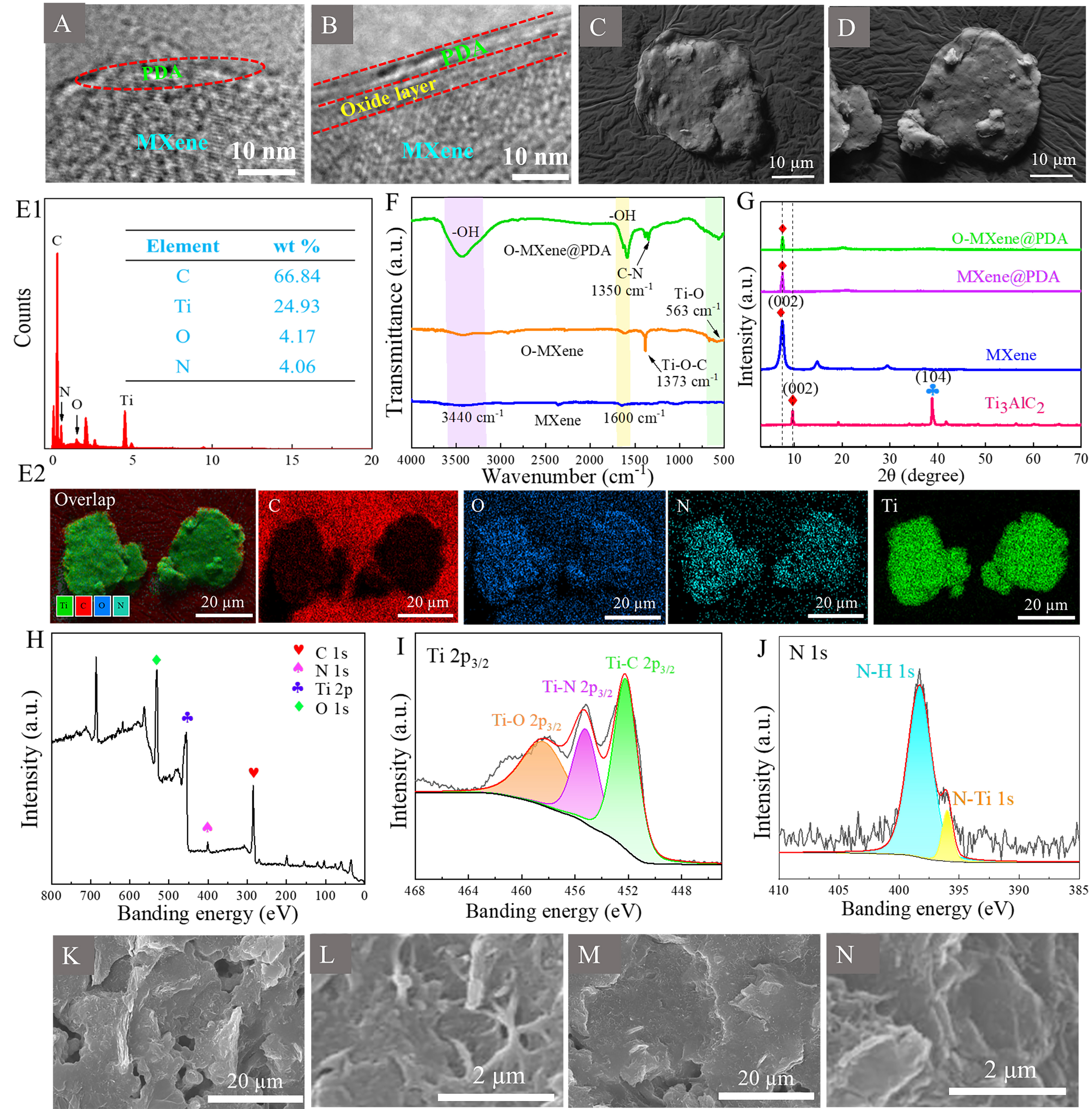

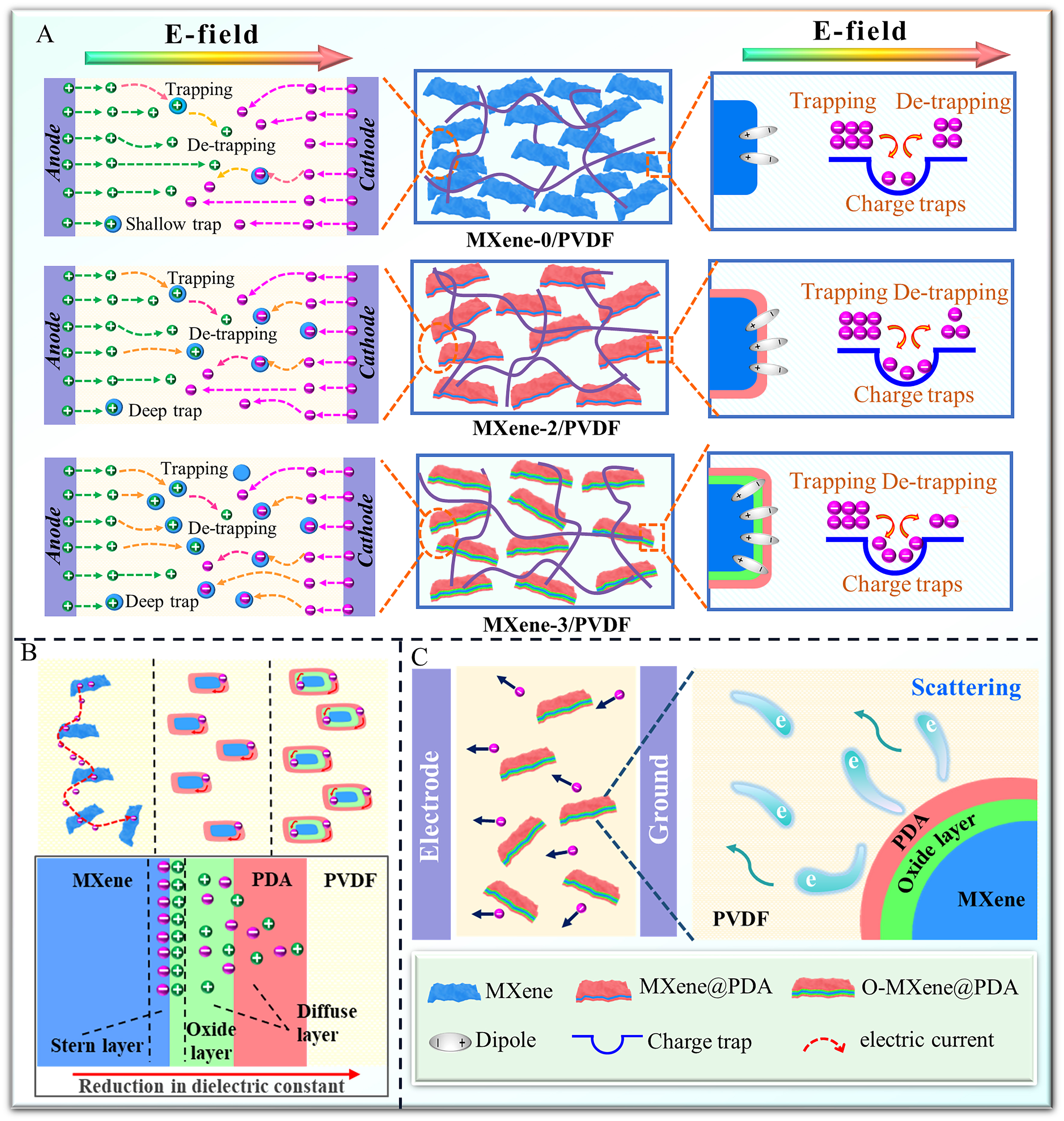
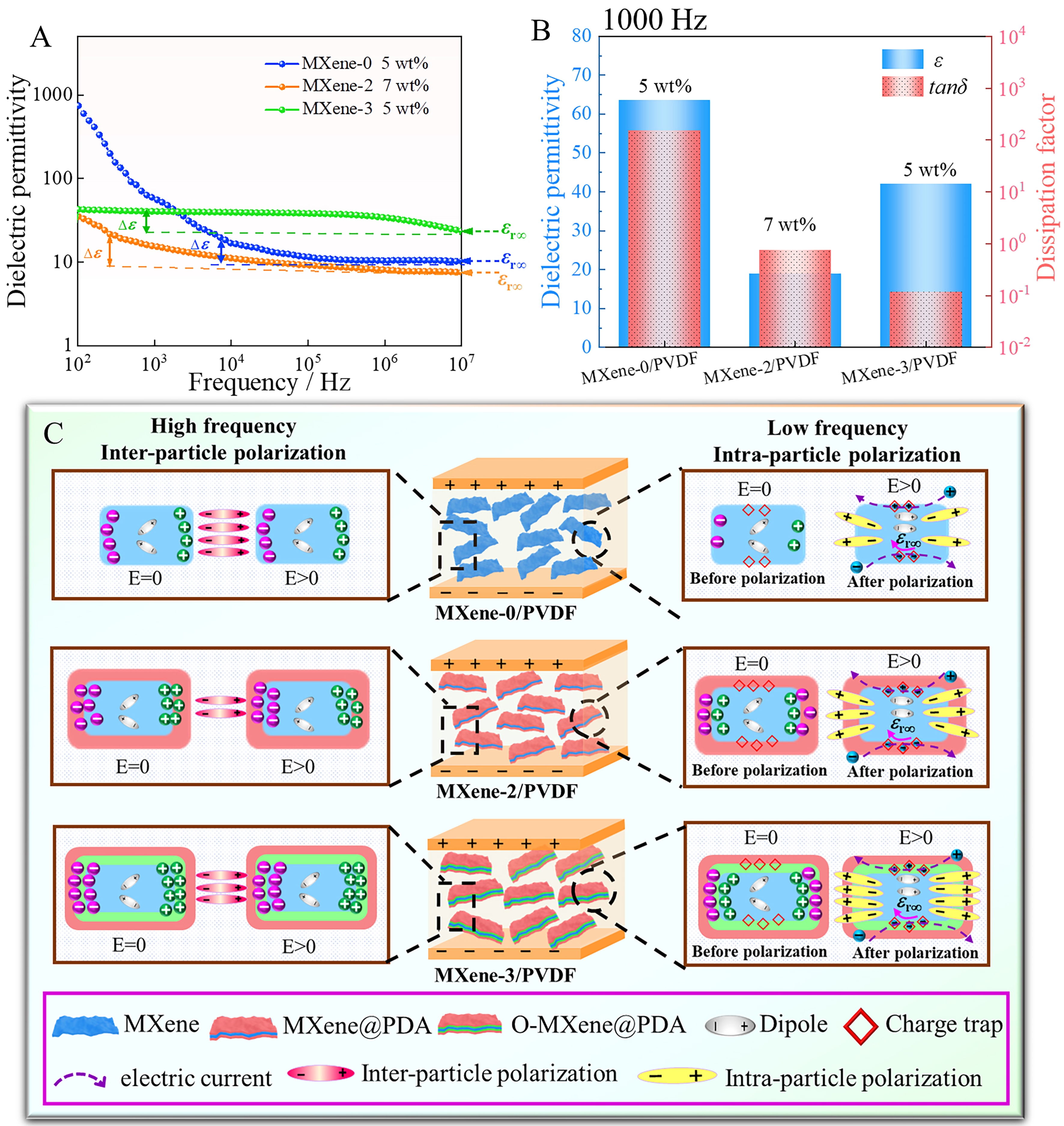

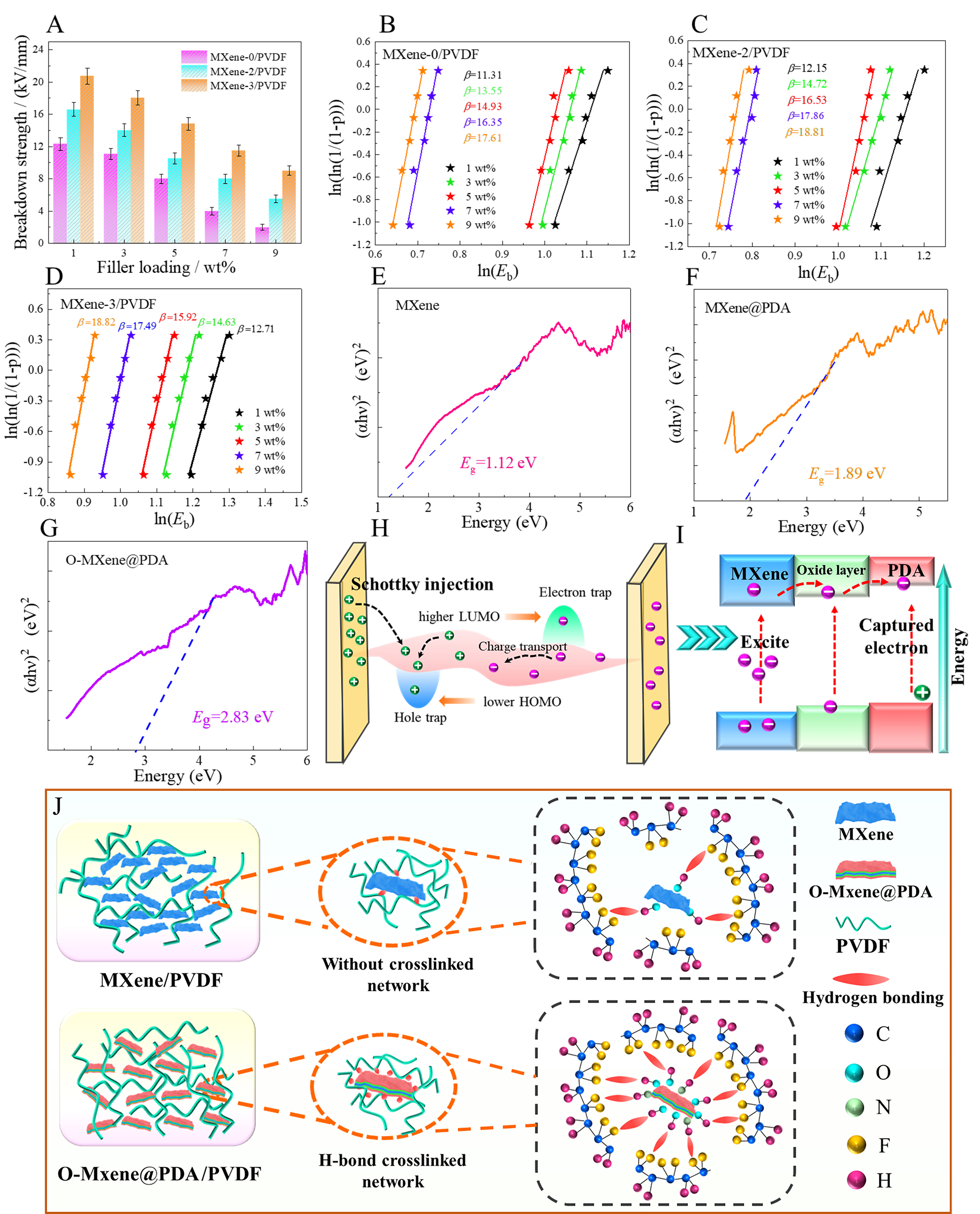
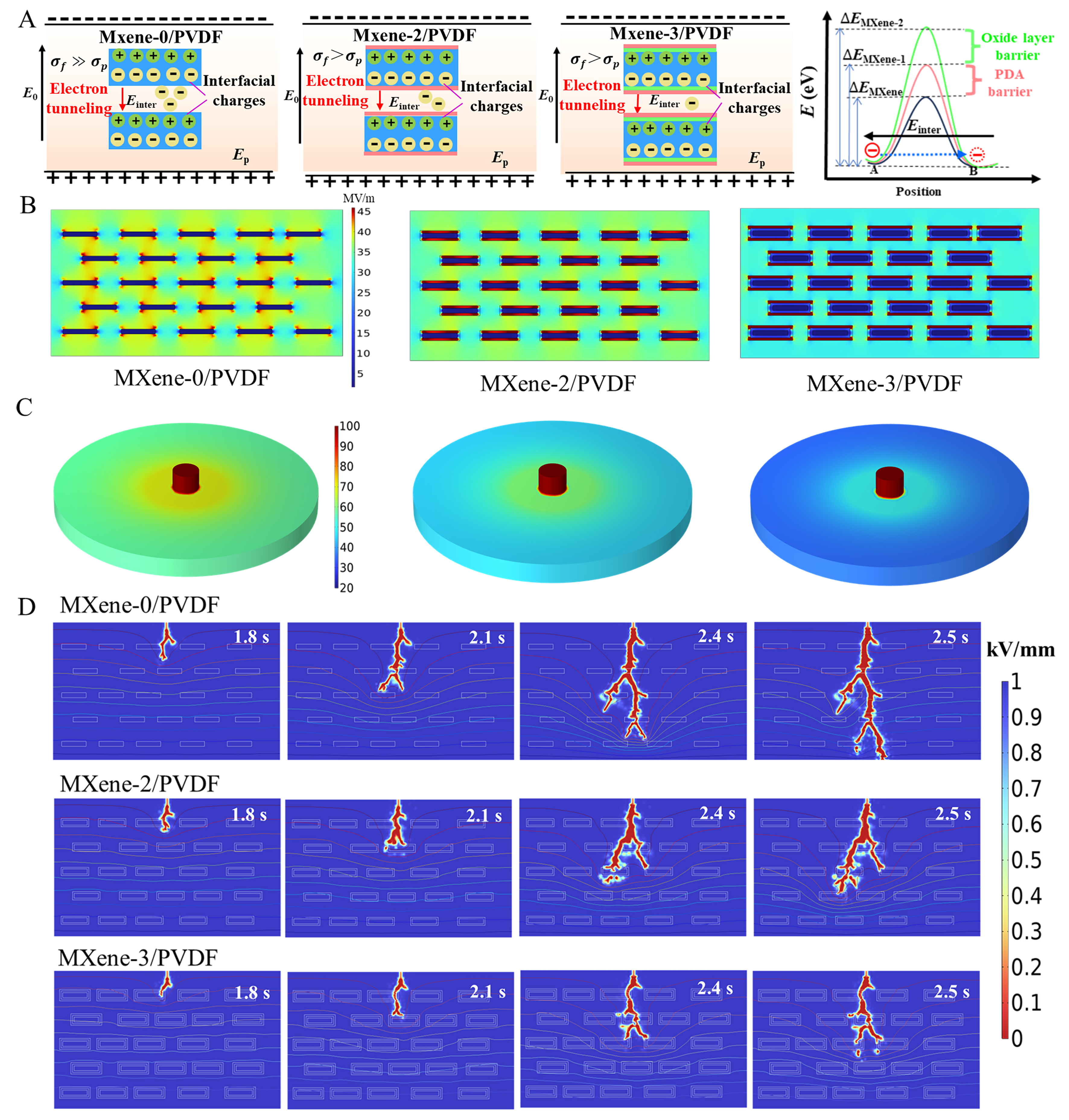
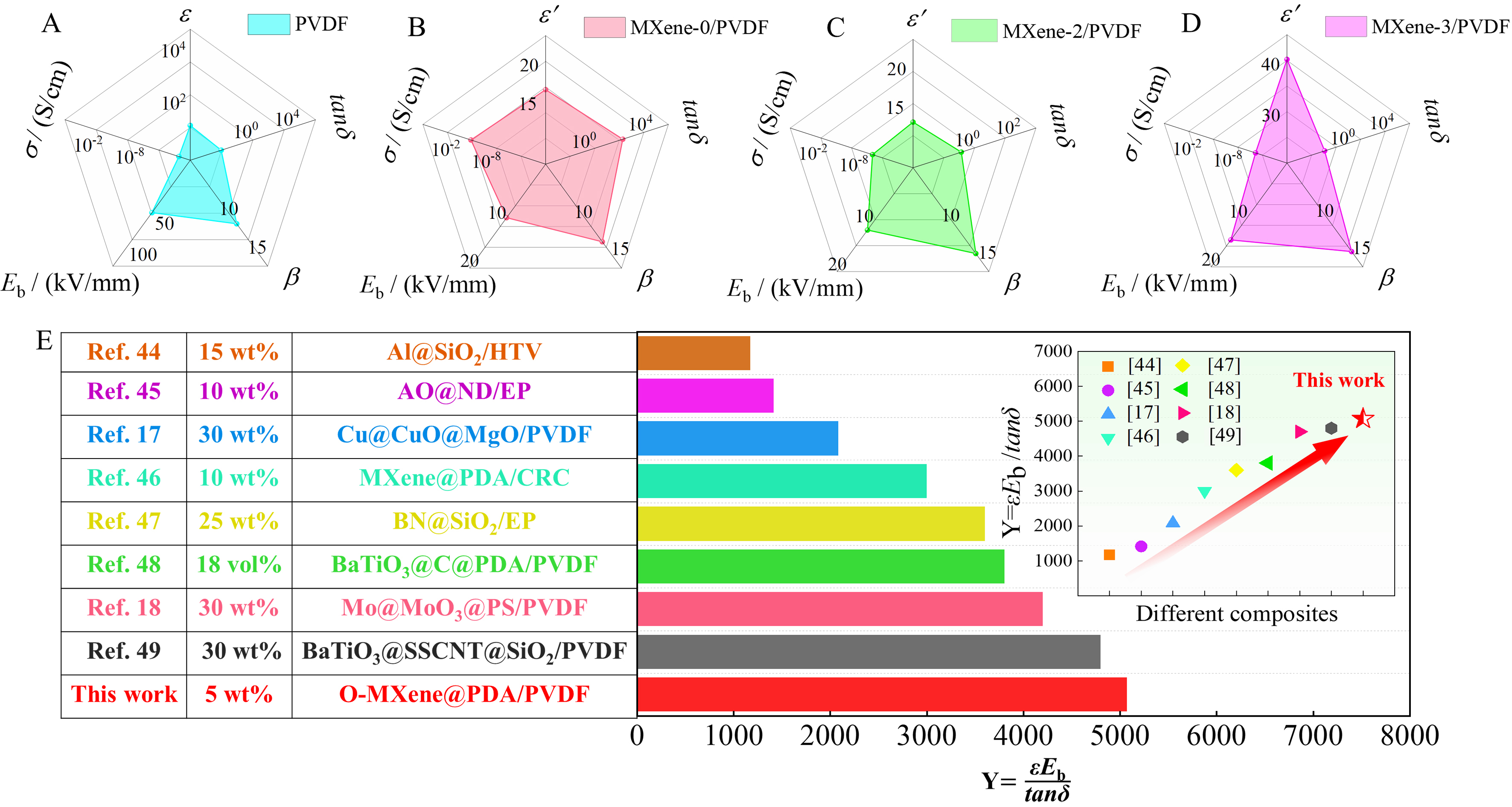












Comments
Comments must be written in English. Spam, offensive content, impersonation, and private information will not be permitted. If any comment is reported and identified as inappropriate content by OAE staff, the comment will be removed without notice. If you have any queries or need any help, please contact us at [email protected].